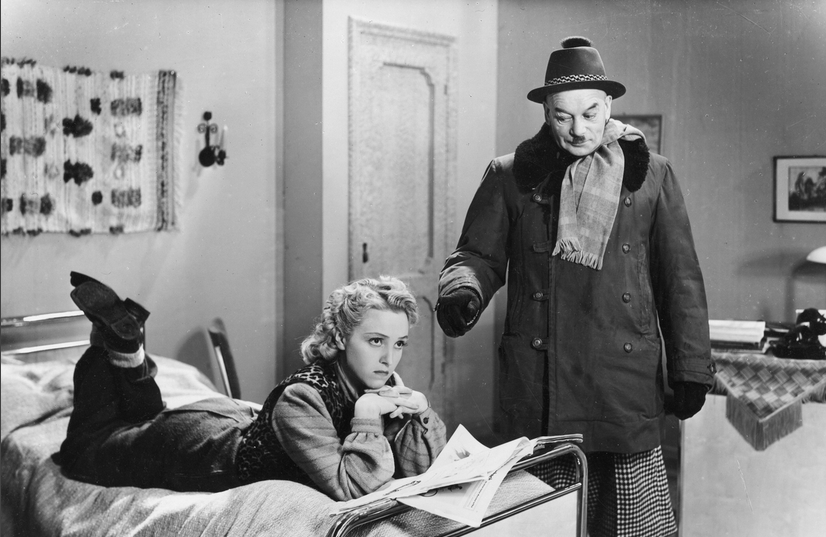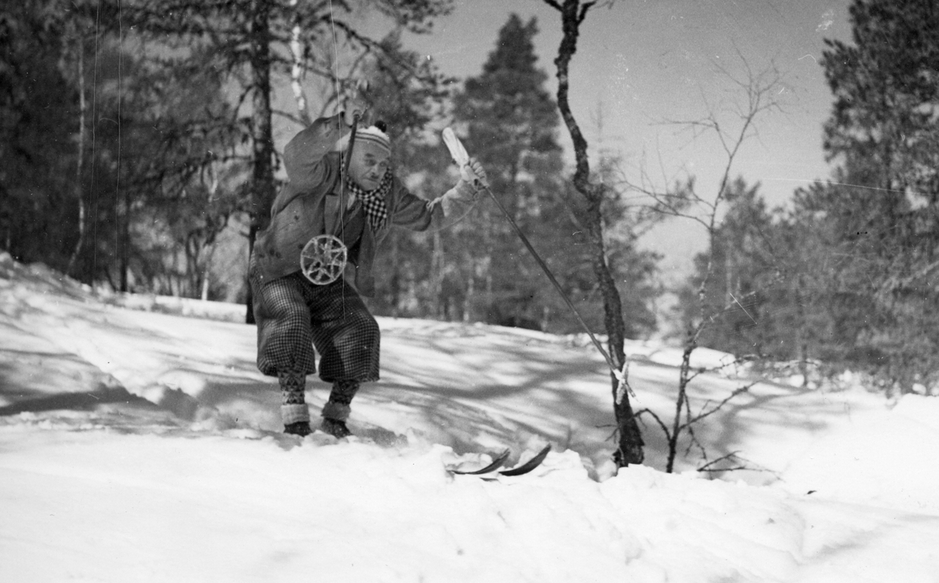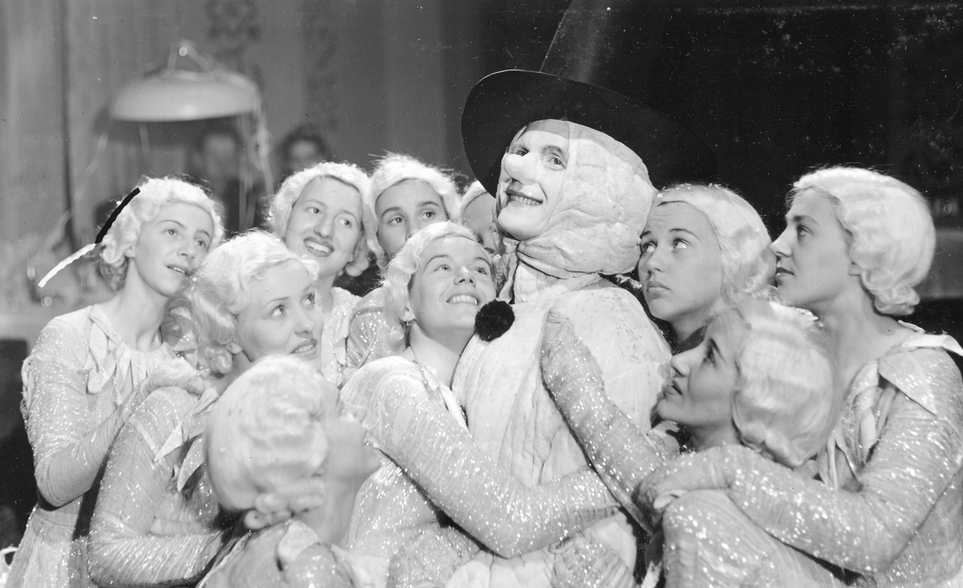
Aku Karpala (Aku Korhonen) is a super-efficient, polyglot concierge at the high-end Hotel Lyx, who prides himself on always making his customers’ stays go perfectly. He is just preparing for a holiday of his own, when he is approached by “Birgit Gyllencrantz” (Ansa Ikonen), who claims to be a wealthy heiress in need of a chaperone. Birgit is in the market for a husband, but having been raised as an orphan by prim aunts in Porvoo, she confesses to being clueless about the world. It would really help if Aku could come along with, pose as her father, and vet any potential suitors in order to filter out the gold-diggers.
Setting aside for a moment, the truth apparently universally acknowledged that potential suitors will throw themselves at Ansa Ikonen, as if shot out of a cannon, the moment she walks into a room, the pair set out, missing the bus and hitching a lift in the open-top car of the dashing Klaus Lang (Turo Kartto), to whom the giddy Birgit takes an immediate shine.
At the Honkaharju hotel, Aku takes his chaperoning far more seriously than Birgit expected, leading her and Klaus to give him the slip so they can canoodle in private. This rather foils Aku’s plan, as he thinks he has found the perfect match for Birgit in the form of the good-hearted Erkki (Joel Rinne), an engineer.

In fact, Klaus really is a gold-digger, and is only after Birgit’s money, a fact he confesses to his real girlfriend, Mirja (Sylvi Palo), within earshot of the scandalised Aku. But Aku himself has to think fast, when he realises that a fellow guest at the hotel is none other than the formidable Mrs Andersson (Siiri Angerkoski) a gruff widow and regular at the Hotel Lyx, who always makes his life a misery, and will be sure to see through his disguise. She is sure that she knows him from somewhere, but can’t quite place him, leading her to be far kinder to him than usual, and culminating in the couple going off for a romantic ride on a one-horse open sleigh.
After a series of confrontations, Birgit checks out of the hotel after paying Aku’s bill, and on the advice of an angry Klaus, Aku returns home and looks through the 9th January issue of the newspaper Uusi Suomi. There, he finds a report of a Porvoo typist, Pirkko Kyllinen, who has become a millionaire after winning the national lottery. Realising that Birgit has been Pirkko all along, Aku tracks her down, brings her to Helsinki, and arranges a reunion with Erkki, who always wanted a normal girl, but common to Finnish farces, is super-pleased that he has also lucked into one that’s now filthy rich.
A closing coda finds a conspicuously flirty Widow Andersson checking back into the Hotel Lyx, and making it known to Aku that she would like to have dinner with him – it’s not like the pair of them haven’t proved to be made for each other in numerous previous films, including Lapatossu, The Heath Cobblers, and SF Parade. Maybe it would be a good time for Aku to lose his ridiculous Hitler moustache, which is one of the items that really dates this film.

The newspapers in Helsinki and Tampere thought that the film was fresh and fun, gently avoiding any mention of the damage done to it in post-production by the onset of the Continuation War, which cost it a composer lost to the draft. The fact that WW2 was underway already during filming supplies one of the film’s little asides, as Aku finds himself serving a British customer and a German customer at the same time, and wisecracks: “Auch wir Finnen können doch bisweilen Diplomaten sein!” [We Finns can sometimes be diplomats, too!] in one of the multiple languages he is seen to speak on screen. Wartime austerity features in the script itself, in the form of a bus that runs on wood chippings, and multiple references to ration books and a song about the Public Welfare Board. It also has some lovely little touches, not the least a cameo by the strikingly beautiful Maj-Len Helin, a multiple champion figure skater who adds a touch of mini-skirted pizzazz to scenes at the ice rink – why on Earth was this her only film…?
In general, the critics seemed to agree that many involved in the film were entirely blameless, including the ever-reliable Aku Korhonen in the leading role – I particularly enjoyed his fussy inability to be a guest at the Hotel Honkaharju, constantly micro-correcting potted plants and foyer arrangements as any good concierge would. Nor did the critics single out Suomen Filmiteollisuus’ first-time director, the former documentarian Hannu Leminen. Instead, any brickbats were aimed firmly at the script itself, which had been written by actor Turo Kartto, who also played Klaus, and claimed to have based his story on an unidentified French farce. Toini Aaltonen in Suomen Sosialidemokratti, always one to note the money-grubbing nature of so many Finnish comedies, found that Kartto’s script failed to “surprise the viewer with any surprises or unique flashes of thought.” You would think that Uusi Suomi, after being a plot point on the film itself, would be a soft touch in the reviews, but far from it. Instead, it made an inevitable joke based on the Finnish title Täysosuma: “Bullseye fails to hit the bullseye,” wrote the paper’s reviewer MV. “It’s not that it went to the side of the goal or over it, but it never even reached it. It’s just too slow.”

In fact, the film contained several technical innovations that largely passed the general viewer by, including a stuntman standing in for Korhonen in skiing scenes, and new recording equipment that led director Leminen to indulge some of the cast’s improvisations and interjections, adding to a naturalistic feel to the dialogue and several charming moments in which off-the-cuff ad-libs are left in the final cut. At one point, Korhonen even seems to break the fourth wall, staring directly into the camera as he laments his fate. An original approach to graphics characterised the opening titles, with credits depicted as scattered labels on suitcases, and the actors introduced with full-screen portraits. And for some reason, there is a dance interlude later in the film which is supposed to be a ballet about snowmen, but comes across as ridiculously creepy, and looks on occasion like xenomorphic eggs from Alien about to leap out and hug your face.
There was also a remarkable amount of location footage of the cast larking about in the snow – a welcome change from the many Finnish farces that bear the legacy production values of a single set in a theatre. If anything risked defeating the production it was the unseasonably warm weather in Kulosaari, which melted all the snow, requiring the production staff to bring more in by the truckful to complete their shots of a supposed winter wonderland.
Jonathan Clements is the author of A Short History of Finland. He is watching all the Finnish films, so you don’t have to.
